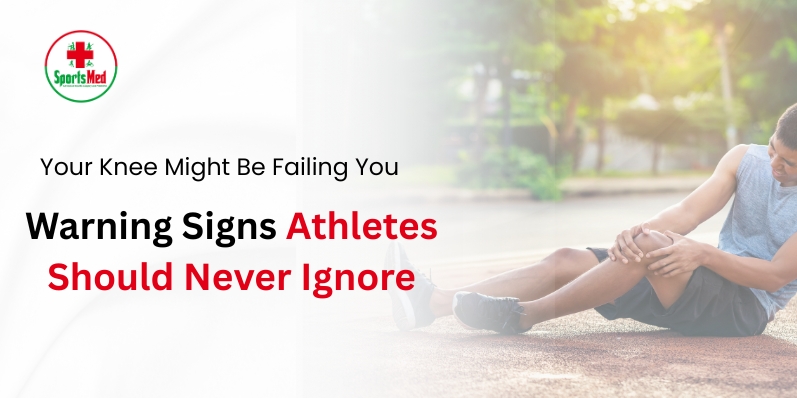
Your Knee Might Be Failing You: Warning Signs Athletes Should Never Ignore
As athletes, our bodies are our greatest asset, and when something starts to go wrong, it can be tough to accept. The knee, in particular, plays a crucial role in almost every sport, from running and jumping to twisting and turning. But because we rely on our knees so much, we often push through pain or discomfort, assuming it's just part of the game. However, some knee issues can be more serious than they seem. Ignoring warning signs can lead to long-term damage and potentially even put an end to your athletic career. So, how can you tell if your knee is on the decline? Let’s take a closer look at the warning signs that athletes should never ignore when it comes to knee pain.
1. Persistent Pain That Won't Go Away
It’s normal to feel some soreness after a tough workout or game, but when pain lingers for days or weeks, it could be a sign that something’s wrong. Persistent pain, especially if it doesn’t improve with rest or ice, may indicate a deeper issue such as tendonitis, cartilage damage, or a ligament injury. If the pain is sharp, intense, or worsens with movement, it’s best to take it seriously and consult a doctor.
2. Swelling That Doesn’t Subside
Swelling in the knee can be a response to an injury, but if your knee stays swollen for an extended period of time, it could point to a more serious condition like a meniscus tear or ligament sprain. The swelling might be accompanied by a feeling of tightness or fullness in the knee joint. Even mild swelling that doesn’t go away over a couple of days should not be ignored. It’s always better to get it checked out.
3. Instability or Weakness in the Knee
If you start feeling like your knee is giving way or feels unstable during activity, it could indicate ligament damage. The knee may buckle or feel like it’s about to give out, which is often a sign that the structures supporting the knee—such as the ACL (anterior cruciate ligament)—might be compromised. This kind of instability can make activities like jumping, running, or even walking difficult and could significantly affect your performance. If you experience this sensation, stop the activity immediately and seek medical advice.
4. Popping, Clicking, or Grinding Sensations
Hearing or feeling popping, clicking, or grinding noises in your knee might be something as simple as air bubbles being released from the joint or your bones moving slightly out of alignment. However, it can also be a sign of cartilage damage or a meniscus tear. If these noises are accompanied by pain, swelling, or instability, it’s time to get checked out by a professional.
5. Limited Range of Motion
If you’re unable to fully extend or bend your knee or feel stiff while trying to do so, it could be a sign of injury or joint inflammation. A limited range of motion could be caused by swelling, joint stiffness, or even a tear in the cartilage or ligaments. Being unable to perform basic movements like squatting or lunging without pain should be a red flag that something might be wrong.
6. Sharp Pain During Specific Movements
While dull aches are common after intense workouts, sharp, localized pain during specific movements—like cutting, pivoting, or landing from a jump—can indicate a problem with your knee’s structures. Whether it's a ligament strain, cartilage tear, or meniscus injury, sharp pain typically signals that there is something more serious going on inside your knee.
7. Inability to Bear Weight
If the pain in your knee is so intense that you can’t put weight on it or walk normally, it's a serious issue that should be addressed immediately. This level of pain could indicate significant ligament damage, fractures, or a serious tear in the cartilage, all of which require professional diagnosis and treatment.
What to Do If You Experience Knee Pain
If you’re experiencing any of the symptoms above, the best course of action is to see a healthcare provider who specializes in sports medicine or orthopedics. A thorough examination, along with imaging (like an MRI or X-ray), can help pinpoint the exact issue and determine the best treatment plan.
In the meantime, consider following the R.I.C.E. method (Rest, Ice, Compression, Elevation) to manage pain and swelling. Avoid putting too much strain on the knee until you have a clear diagnosis.
Prevention Is Key
While some knee injuries are unavoidable, there are ways to reduce your risk. Strengthening the muscles around the knee, such as your quads, hamstrings, and calves, can help stabilize the joint. Flexibility exercises, proper warm-ups, and using the right footwear for your sport can also help prevent unnecessary strain on the knee.
Conclusion
Knee injuries are a common problem for athletes, but the key is to recognize the warning signs early. Don’t ignore persistent pain, swelling, or instability. Your knee may be trying to tell you something important. Listen to your body, get checked by a professional, and take steps to protect your knees.